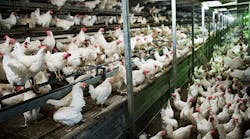Cal-Maine Foods Inc. has reached an agreement with EPA and U.S. Department of Justice that resolves Clean Water Act violations at the company’s poultry egg production facility in Edwards, Miss.
Under the settlement, Cal-Maine will bring the facility into compliance with its state-issued water discharge permit, significantly reduce nutrient pollution discharges and improve environmental data collection and reporting practices. The company also will pay a $475,000 penalty to be split evenly between the U.S. Federal and Mississippi governments.
Once the pollution controls required by the settlement are implemented, EPA estimates Cal-Maine will cut discharges of nitrogen by 89,000 pounds and phosphorous by 20,000 pounds per year. EPA estimates it will cost Cal-Maine approximately $418,000 to implement the settlement requirements and bring the Edwards facility into compliance with state and federal clean water laws.
“Clean Water Act violations from agricultural facilities can impair drinking water sources, transmit disease-causing bacteria and endanger our lakes and rivers,” said Cynthia Giles, assistant administrator for EPA’s Office of Enforcement and Compliance Assurance. “When concentrated animal feeding operations discharge pollutants into U.S. waters, the law requires them to have a permit and comply with it. We’re committed to enforcing the law to protect water quality for communities like the one where this facility is located.”
The settlement, a consent decree filed in federal court in the Southern District of Mississippi Northern Division, resolves alleged violations of Cal-Maine’s Clean Water Act National Pollutant Discharge Elimination System (NPDES) permit at its facility in Edwards, a large concentrated animal feeding operation that houses more than 2 million chickens. Cal-Maine discharged pollutants from the production area into a tributary of a nearby creek without NPDES permit authorization, and applied nitrogen-laden wastewater on fields at the facility during winter months when land application was prohibited and sometimes at rates that exceeded their permit requirements. Cal-Maine also committed hundreds of water sampling, recordkeeping and reporting violations.
“This is good news for water quality and health for the residents of Edwards by requiring that Cal-Maine's facilities operate in accordance with state and federal laws,” said U.S. Attorney Gregory K. Davis for the Southern District of Mississippi. “The settlement also represents the commitment by the Justice Department and our federal and state partners to protect water, air and land from health hazards and pollution.”
The facility is located in a community where close to half of the households have an annual income of less than $25,000. One of EPA's top priorities is to protect communities that are disproportionately affected by pollution.
Too much nitrogen and phosphorus in the water causes algae to grow faster than ecosystems can handle. Large growths of algae, known as algal blooms, contribute to the creation of hypoxia or “dead zones” in water bodies where oxygen levels are so low that most aquatic life cannot survive. Excessive nitrogen and phosphorus that washes into water bodies and is released into the air are often the direct result of human activities, and agricultural operations are one of the major sources of nutrient pollution.
“The Justice Department is committed to protecting clean water for all Americans, and ensuring large concentrated animal feeding operations are good neighbors to those communities living near them like Edwards,” said Assistant Attorney General John Cruden for the Justice Department’s Environment and Natural Resources Division. “This settlement will bring Cal-Maine into compliance with state and federal laws and cut nutrient pollution discharges into area waterways.”
Under the settlement, Cal-Maine already is developing and implementing: procedures for its egg production and land application areas to achieve compliance with its NPDES permit, an employee training policy, and improved recordkeeping and reporting practices. The procedures were submitted to, and reviewed and approved by EPA and Mississippi officials over the course of settlement negotiations. Cal-Maine has begun implementing these procedures and must comply with all the terms of the settlement by April 30, 2016.
This case is part of EPA’s National Enforcement Initiative to prevent animal waste from contaminating surface and ground water.
